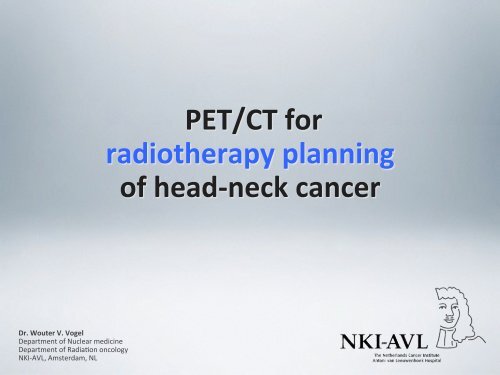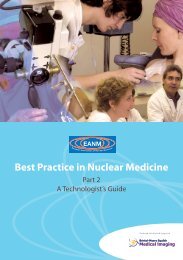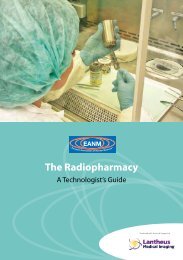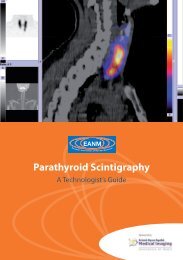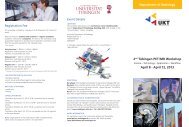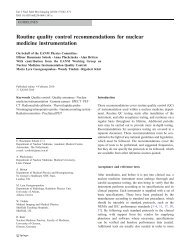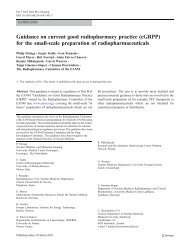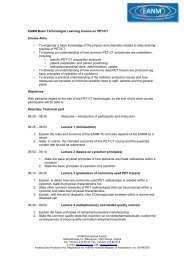PET/CT for radiotherapy planning of head-âÂÂneck cancer
PET/CT for radiotherapy planning of head-âÂÂneck cancer
PET/CT for radiotherapy planning of head-âÂÂneck cancer
You also want an ePaper? Increase the reach of your titles
YUMPU automatically turns print PDFs into web optimized ePapers that Google loves.
Dr. Wouter V. Vogel<br />
Department <strong>of</strong> Nuclear medicine<br />
Department <strong>of</strong> Radia3on oncology<br />
NKI-‐AVL, Amsterdam, NL<br />
<strong>PET</strong>/<strong>CT</strong> <strong>for</strong><br />
<strong>radiotherapy</strong> <strong>planning</strong><br />
<strong>of</strong> <strong>head</strong>-‐neck <strong>cancer</strong>
Disclosure slide<br />
! Research Support: none<br />
! Consultant: none<br />
! Speakers Bureau: none<br />
! Honoraria and/or Stockholder: none<br />
2<br />
/ 86
Topics<br />
! Why <strong>PET</strong>/<strong>CT</strong> ?<br />
! Diagnos3c value<br />
! Tumor delinea3on<br />
! Tumor characteriza3on<br />
! How to do it<br />
! Requirements<br />
! Image fusion<br />
! Collabora3ons<br />
! Radia3on protec3on<br />
! Future perspec3ve<br />
3<br />
/ 86
Required in<strong>for</strong>maAon<br />
! Loca3on<br />
! Type<br />
! Size<br />
! Volume<br />
! Mucosal spread<br />
! Deep infiltra3on<br />
! Node metastases<br />
! Distant metastases<br />
! Stage<br />
! Pa3ënt characteris3cs<br />
! HPV / EBV<br />
! Et cetera …<br />
4<br />
/ 86
Anatomical imaging with <strong>CT</strong><br />
Based on Assue density<br />
! Anatomical orienta3on<br />
! Recogni3on / delinea3on <strong>of</strong> cri3cal normal organs<br />
! Recogni3on / delinea3on <strong>of</strong> tumor loca3ons<br />
! Required <strong>for</strong> RT <strong>planning</strong> electron density map<br />
5<br />
/ 86
A mulAmodality diagnosis<br />
Clinical evaluaAon<br />
! History<br />
! Inspec3on<br />
! Biopsies<br />
! Experience<br />
???<br />
tumor<br />
AddiAonal imaging<br />
! Ultrasound<br />
! (ce)MRI<br />
! DWI, spectroscopy<br />
! Endoscopy, et cetera<br />
6<br />
/ 86
Molecular imaging<br />
! Is a visual func3on test<br />
! Does not provide borders<br />
<strong>of</strong> 3ssues, but borders <strong>of</strong><br />
func3ons<br />
7<br />
/ 86
FDG <strong>PET</strong>/<strong>CT</strong><br />
<strong>for</strong> selecAon <strong>of</strong> <strong>radiotherapy</strong>
Reasons to per<strong>for</strong>m <strong>PET</strong>/<strong>CT</strong><br />
! Does the pa3ent have <strong>cancer</strong> ?<br />
! Where is it located, and what stage ?<br />
! Is <strong>radiotherapy</strong> appropriate ?<br />
! Op3mizing the treatment<br />
9<br />
/ 86
Finding a primary tumor<br />
DetecAon rate FDG <strong>PET</strong> aIer negaAve convenAonal work-‐up<br />
! 25% Rusthoven, Review, Cancer 2004<br />
! 29% Johansen, DAHANCA-‐13, Head Neck 2008<br />
10<br />
/ 86
Are there nodal metastases?<br />
DetecAon <strong>of</strong> nodal disease<br />
! Meta-‐analysis <strong>of</strong> 32 studies<br />
! Sensi3vity 81-‐90%<br />
! Specificity 89-‐90%<br />
<strong>PET</strong> outper<strong>for</strong>ms <strong>CT</strong> and MRI <strong>for</strong><br />
detec3on <strong>of</strong> node metastases in<br />
the neck, and it is the best non-‐<br />
invasive instrument available<br />
Impact on treatment<br />
! Upgrade elec3ve nodal field areas to high dose RT<br />
11<br />
/ 86
Characterizing extra findings<br />
Coin lesion FDG <strong>PET</strong>/<strong>CT</strong><br />
! Sensi3vity 97%<br />
! Specificity 79%<br />
Impact on treatment<br />
! Nega3ve Follow-‐up<br />
! Posi3ve Biopsy<br />
(or treatment)<br />
12<br />
/ 86
Are there distant metastases?<br />
For the presence <strong>of</strong> M1 disease<br />
! Sensi3vity 93%<br />
! Specificity 96%<br />
Impact on treatment<br />
! Swith RT from cura3ve to<br />
pallia3ve intent in 15% <strong>of</strong> cases<br />
afer M0 conven3onal workup.<br />
Na3onal Ins3tute <strong>for</strong> Clinical Excellence (NICE). Lung <strong>cancer</strong>: the<br />
diagnosis and treatment <strong>of</strong> lung <strong>cancer</strong>. In: Clinical Guideline No.: 24.<br />
NICE Web site. 2005<br />
13<br />
/ 86
Conclusion<br />
! FDG-‐<strong>PET</strong>/<strong>CT</strong> is important <strong>for</strong> <strong>radiotherapy</strong><br />
be<strong>for</strong>e you even started<br />
Examples <strong>of</strong> diseases where RT treatment<br />
is currently selected with <strong>PET</strong>/<strong>CT</strong><br />
! Lung <strong>cancer</strong><br />
! Head-‐neck<br />
! Lymphoma<br />
! Gynaecological<br />
! Melanoma<br />
! Breast <strong>cancer</strong> (recurrence)<br />
! Prostate <strong>cancer</strong> (recurrence, choline)<br />
! Brain tumors (methionine)<br />
! … et cetera<br />
14<br />
/ 86
MulAmodality<br />
more than nice colors ?
Understanding molecular imaging<br />
The in<strong>for</strong>ma3on <strong>of</strong> molecular imaging on its own<br />
can be virtually meaningless<br />
16<br />
/ 86
MulAmodality: the greater perspecAve<br />
The in<strong>for</strong>ma3on <strong>of</strong> molecular imaging on its own<br />
is virtually meaningless<br />
17<br />
/ 86
Imaging modaliAes<br />
1895 X-‐ray Wilhelm C. Röntgen<br />
1940 Fluorescence microsc. Coons and Kaplan<br />
1946 NMR spectroscopy F. Bloch and E. Purcell<br />
1948 Ultrasound George Ludwig<br />
1953 ScinAgraphy Hal Anger<br />
1963 SPE<strong>CT</strong> Kuhl and Edwards<br />
1970 <strong>PET</strong> Brownell<br />
1973 MRI Paul Lauterbur<br />
1975 <strong>CT</strong> Robert S. Ledley<br />
1979 US doppler Ge<strong>of</strong>f Stevenson<br />
New techniques never replace old ones,<br />
we are just ge\ng more opAons.<br />
18<br />
/ 86
Planar image fusion<br />
1953 Thyroid scin3graphy and photograph <strong>of</strong> a pa3ent<br />
1960 Bonescan and X-‐rays<br />
19<br />
/ 86
Common pracAce today<br />
21<br />
/ 86
Radiotherapy<br />
what do we need?
TherapeuAc raAo<br />
100%<br />
Effect<br />
Tumour control<br />
Slide 23<br />
Normal tissue damage<br />
/ 86
Increase therapeuAc raAo<br />
• Increase tumour sensitivity to irradiation<br />
• eg add chemotherapy, decrease hypoxia<br />
• Decrease normal tissue sensitivity to irradiation<br />
• eg amifostine<br />
• Increase con<strong>for</strong>mality <strong>of</strong> irradiation<br />
• Focus on tumour<br />
• Avoid organs at risk<br />
This is where <strong>PET</strong> comes into play<br />
Slide 24<br />
/ 86
GTV<br />
Gross Tumor Volume<br />
based on:<br />
Imaging modalities<br />
Diagnostic modalities<br />
(pathology/histology)<br />
Clinical examination<br />
Slide 25<br />
/ 86
<strong>CT</strong>V<br />
Clinical Target Volume<br />
GTV with margin<br />
accounting <strong>for</strong> sub-clinical<br />
microscopic extension<br />
This volume needs to be<br />
treated accurately to<br />
assure treatment efficacy.<br />
e.g.: <strong>CT</strong>V=GTV+0.5 cm<br />
<strong>CT</strong>V is a anatomicalclinical<br />
volume<br />
Slide 26<br />
/ 86
PTV<br />
Planning Target Volume<br />
<strong>CT</strong>V encompassed with<br />
margin <strong>for</strong>:<br />
Organ motion<br />
Daily patient setup<br />
Machine setup<br />
Intra-treatment<br />
variations<br />
…<br />
PTV is a geometrical<br />
concept<br />
Slide 27<br />
/ 86
RT <strong>planning</strong> process<br />
Item<br />
Item 1<br />
• Item 2<br />
• Item 3<br />
Slide 28<br />
/ 86
RT <strong>planning</strong> process<br />
Radiotherapy requires a uni<strong>for</strong>m dose distribution within the tumor.<br />
Target dose uni<strong>for</strong>mity within +7% and -5% <strong>of</strong> the prescribed tumor dose.<br />
While sparing surrounding normal tissues<br />
To achieve this goal multiple beams are used<br />
Main steps in Treatment Planning<br />
1. Define treatment volumes and risk organs<br />
2. Define optimal beam setup<br />
3. Calculate dose distribution within the patient<br />
and treatment times per beam<br />
4. Plan evaluation<br />
Slide 29<br />
/ 86
Sources <strong>of</strong> errors<br />
Inaccurate beam data<br />
Wrong monitor unit calibration<br />
Inaccurate beam measurements<br />
Wrong beam geometry<br />
Slide 30<br />
Accuracy <strong>of</strong> volume definition<br />
With advanced treatment techniques only voxels labeled as tumor will be<br />
irradiated<br />
Target volume delineation becomes extremely important<br />
Inter- and Intra-observer variations should be mimimized<br />
Accuracy <strong>of</strong> image fusion<br />
Patient repositioning<br />
Image registration <strong>CT</strong> / MR / <strong>PET</strong><br />
Data transfer/consistency between RTP and Linac<br />
And many more potential problems...<br />
/ 86
The result we try to get<br />
You need <strong>CT</strong><br />
! Anatomical reference<br />
! Tumor delinea3on<br />
! Electron density map<br />
PaAent benefit<br />
! Bener cura3on/survival<br />
! Less side-‐effects<br />
! Bener quality <strong>of</strong> life<br />
<strong>PET</strong> imaging adds<br />
! Sensi3ve tumor detec3on<br />
! Discrimina3on tumor / benign<br />
! Consistent tumor delinea3on<br />
! Quan3fy tumor characteris3cs<br />
Impact on <strong>planning</strong><br />
! Improve <strong>planning</strong> accuracy<br />
! Higher dose to tumor<br />
! Lower dose to normal 3ssues<br />
! (Adapt to tumor characteris3cs)<br />
31<br />
/ 86
PotenAal problems<br />
<strong>PET</strong>/<strong>CT</strong> imaging can cause<br />
! FN: missing tumor 3ssue<br />
! FP: including benign 3ssues<br />
! Misposi3on tumor 3ssue<br />
! False tumor characteris3cs<br />
ResulAng in<br />
! Decreased curaAon/survival<br />
! More side-‐effects<br />
! Reduced quality <strong>of</strong> life<br />
Impact on <strong>planning</strong><br />
! Degrade <strong>planning</strong> accuracy<br />
! Reduce effec3ve dose to tumor<br />
! Increase dose to normal 3ssues<br />
32<br />
/ 86
Technical<br />
requirements
StandardizaAon <strong>of</strong> <strong>PET</strong>/<strong>CT</strong> imaging<br />
! Indica3ons<br />
! Pa3ent prepara3on<br />
! Image acquisi3on<br />
! Image reconstruc3on<br />
! Viewing<br />
! Quan3fica3on<br />
! Delinea3on<br />
! Repor3ng<br />
! Impact<br />
35<br />
/ 86
<strong>PET</strong> <strong>for</strong> radiaAon oncology<br />
! Large bore<br />
! Flat table<br />
! Laser posi3oning<br />
! Posi3oning aids<br />
! Planning <strong>CT</strong><br />
! (4D gated)<br />
36<br />
/ 86
AddiAonal paAent posiAoning<br />
Repeated posiAoning is not a problem !<br />
Modality Repeats<br />
! Planning <strong>CT</strong> / MR 1 – 2<br />
! Addi3onal <strong>PET</strong> (/<strong>CT</strong>) 1<br />
! Radia3on treament 25 – 50<br />
37<br />
/ 86
Required accuracy<br />
Small errors in pa3ent (re)posi3oning are expected,<br />
and are compensated with a margin around the GTV.<br />
This is the PTV.<br />
Acceptable PTV margins<br />
depend on the body part<br />
! Head/neck ~ 5 mm<br />
! Colorectal ~ 10 mm<br />
! Lungs ~ 20 mm<br />
craniocaudal<br />
PosiAoning or image fusion errors on <strong>PET</strong>/<strong>CT</strong><br />
should not exceed the standard PTV margins<br />
38<br />
/ 86
Head/neck<br />
Required<br />
! Flat table<br />
! Customised <strong>head</strong>/neck support<br />
! Personalised mask<br />
! Mask clamps<br />
! Knee support<br />
! (Laser guides)<br />
39<br />
/ 86
Example: NO MASK<br />
40<br />
/ 86
Example: NO MASK<br />
Please don’t<br />
try this at<br />
home<br />
41<br />
/ 86
Example: SubopAmal mask placement<br />
42<br />
/ 86
Example: SubopAmal mask placement<br />
Validate your new<br />
approach and skills<br />
with experts<br />
43<br />
/ 86
Well-‐trained personnel<br />
RecommendaAons<br />
! Accept a learning curve <strong>for</strong> pa3ent posi3oning<br />
! Collaborate with <strong>radiotherapy</strong> department staff<br />
! Train a dedicated <strong>PET</strong> <strong>planning</strong> staff<br />
44<br />
/ 86
Example: Success<br />
Results<br />
! Image registra3on error < 3 mm (Vogel et al, JNM 2007)<br />
! Correla3on <strong>of</strong> lesions < 5 mm possible<br />
! PTV margins 0.5 cm<br />
45<br />
/ 86
Tumor contouring<br />
using a <strong>PET</strong> signal
DelineaAon: a mulAmodality procedure<br />
Clinical evaluaAon<br />
! History<br />
! Inspec3on<br />
! Biopsy, histology<br />
! Experience<br />
AddiAonal imaging<br />
! Ultrasound<br />
! (ce)<strong>CT</strong><br />
! (ce)MRI, DWI, spectro<br />
! Endoscopy, et cetera…<br />
47<br />
/ 86
What does FDG <strong>PET</strong> show ?<br />
The signal comes from<br />
! Cells that proliferate<br />
! Cells that have de-‐differen3ated<br />
! Cells that have high Glut-‐1 expression<br />
! Cells that are hypoxic<br />
<strong>PET</strong> iden3fies voxels that<br />
contain a lot <strong>of</strong> cells, that<br />
tend to be radioresistent<br />
48<br />
/ 86
What does FDG <strong>PET</strong> not show ?<br />
Volumes with a low<br />
concentraAon <strong>of</strong><br />
vital tumor cells<br />
! Microscopic extent<br />
! Superficial spread<br />
! Diffuse infiltra3on<br />
! Necro3c parts<br />
! (Well-‐differen3ated<br />
tumor parts)<br />
49<br />
/ 86
What volume do you need to know?<br />
From a surgical point <strong>of</strong> view<br />
! All tumor<br />
From a biological point <strong>of</strong> view<br />
! All tumor mee3ng certain diagnos3c criteria<br />
! All tumor relevant <strong>for</strong> a treatment decision<br />
From a radiotherapeuAc point <strong>of</strong> view<br />
! PTV The total volume to be irradiated<br />
! <strong>CT</strong>V The clinically relevant area, likely to contain tumor<br />
! GTV All known tumor containing areas<br />
! Boost A biological subvolume <strong>of</strong> the tumor volume<br />
50<br />
/ 86
<strong>PET</strong> <strong>for</strong> GTV<br />
GTV involves all known tumor locaAons<br />
! GTV involves all known tumor loca3ons<br />
! <strong>PET</strong> does not show them all<br />
! <strong>PET</strong> does not provide the GTV<br />
! <strong>PET</strong> can contribute to GTV defini3on, just like any other scan<br />
51<br />
/ 86
DelineaAon methods<br />
Available strategies<br />
! Visual / manual<br />
! SUV<br />
! % <strong>of</strong> tumor ac3vity<br />
! % <strong>of</strong> background ac3vity<br />
! Ra3o tumor -‐ background<br />
! Advanced algorithms<br />
This choice is not trivial !<br />
! Resul3ng volume depends heavily on the method<br />
! There is insufficient valida3on <strong>for</strong> all methods<br />
! At least a fixed SUV threshold is not suitable<br />
! A “best method” is currently not iden3fiable<br />
Schinagl et al., IJRBOP 2007<br />
52<br />
/ 86
Impact on volumes<br />
Method<br />
! GTV 40 53.6 mL<br />
! GTV bg 94.7 mL<br />
! GTV vis 157.7 mL<br />
! GTV 2.5 164.6 mL<br />
(Nestle, JNM 2005)<br />
53<br />
/ 86
FDG <strong>PET</strong> versus pathology<br />
Every technique<br />
has issues<br />
! False posi3ves<br />
! False nega3ves<br />
! Limited resolu3on<br />
! Non-‐linearity<br />
! Mul3-‐factorial signal<br />
! Interpreta3on issues<br />
Tumor volume in pharyngolaryngeal<br />
squamous cell carcinoma: comparison at <strong>CT</strong>,<br />
MR imaging, and FDG <strong>PET</strong> and valida3on<br />
with surgical specimen.<br />
Daisne et al. Radiology. 2004;233(1):93-‐100<br />
54<br />
/ 86
A visual mulAmodality approach<br />
x<br />
! x<br />
55<br />
/ 86
Reduce interobserver variaAon<br />
Observer varia3on in target volume delinea3on <strong>of</strong> lung <strong>cancer</strong> related to radia3on<br />
oncologist-‐computer interac3on: a 'Big Brother' evalua3on. Steenbakkers RJ et al.<br />
Radiother Oncol. 2005 Nov;77(2):182-‐90.<br />
56<br />
/ 86
Interobserver variaAon – No <strong>PET</strong><br />
57<br />
/ 86
Interobserver variaAon – With FDG-‐<strong>PET</strong><br />
Huge improvement !<br />
58<br />
/ 86
StandardizaAon <strong>of</strong> delineaAon<br />
! Delinea3on algorithm<br />
! Image reconstruc3on<br />
! Color scales<br />
! Protocols<br />
Whatever you choose, it will instantly fail when<br />
! Switching from 3D to 4D in lung <strong>cancer</strong><br />
! Buying a new <strong>PET</strong> scanner<br />
! Using a different tracer<br />
59<br />
/ 86
Non-‐homogeneous <strong>PET</strong><br />
<strong>PET</strong> oIen does not represent the tumor as a whole, and will not<br />
replace <strong>CT</strong>, MR, or other means to find tumor volume and borders<br />
<strong>PET</strong> can be used to idenAfy a biological subvolume<br />
Defining Radiotherapy Target Volumes Using (18)F-‐Fluoro-‐Deoxy-‐Glucose Positron<br />
Emission Tomography/Computed Tomography: S3ll a Pandora's Box?<br />
Devic S et al. Int J Radiat Oncol Biol Phys. 2010 Jun 18.<br />
60<br />
/ 86
<strong>PET</strong> <strong>for</strong> Boost definiAon<br />
A boost field involves an important tumor subvolume<br />
! A boost is required <strong>for</strong> areas with<br />
! A high number <strong>of</strong> cells to kill<br />
! Rela3vely radioresistent cells (hypoxia)<br />
! FDG <strong>PET</strong> shows exactly those areas<br />
! <strong>PET</strong> can define a boost area<br />
When <strong>PET</strong> dictates the shape <strong>of</strong> a high-‐dose RT field,<br />
the procedure needs to be highly standardized!<br />
61<br />
/ 86
Day-‐to-‐day problems<br />
Scans have different characterisAcs with regard to<br />
! Image resolu3on, par3al volume effects, blurring<br />
! Involuntary pa3ent mo3on, swallowing<br />
What is the truth ???<br />
62<br />
/ 86
Day-‐to-‐day problems<br />
Factors leading to significant tumor locaAon differences in mask<br />
! Positron drif (2-‐5 mm)<br />
! Pa3ent mo3on (swallowing)<br />
What is the truth ???<br />
63<br />
/ 86
Summary <strong>of</strong> delineaAon<br />
Who needs <strong>PET</strong> <strong>for</strong> volume definiAon ?<br />
! GTV delinea3on when difficult on <strong>CT</strong>/MR/clinical evalua3on<br />
! Boost defini3on in scien3fic research<br />
And how to do it?<br />
! Be aware <strong>of</strong> the limita3ons <strong>of</strong> <strong>PET</strong><br />
! GTV: No definite strategy yet, use a holis3c approach<br />
! Boost: Prefer automa3c, use one algorithm and s3ck to that<br />
64<br />
/ 86
Moving from<br />
tumor contouring<br />
to<br />
biological evaluaAon
Contouring a signal<br />
66<br />
/ 86<br />
Claude Monet<br />
Impression, Sunrise<br />
(1874)<br />
Considered to be<br />
the first<br />
impressionist<br />
pain3ng
From where to what<br />
The Roman Dodecahedra<br />
Courtesy U. Nestle, Freiburg<br />
67<br />
/ 86
What are we currently NOT doing ?<br />
InterpretaAon <strong>of</strong> the biological acAvity inside the GTV/boost<br />
! Op3mal dose ?<br />
! Op3mal frac3ona3on scheme ?<br />
! Inhomogeneous treatment ?<br />
! Radiotherapy the best choice ?<br />
! Radiosensi3zers needed ?<br />
! Is the tumor responding ?<br />
! Adapt or switch treatment ?<br />
! Adjuvant chemo or surgery ?<br />
68<br />
/ 86
FDG uptake predicts RT outcome<br />
[18F]fluorodeoxyglucose uptake by positron emission tomography predicts outcome <strong>of</strong> non-‐small-‐cell lung <strong>cancer</strong>.<br />
Sasaki R et al. J Clin Oncol. 2005 Feb 20;23(6):1136-‐43.<br />
69<br />
/ 86<br />
! Poten3al impact<br />
on required RT<br />
dose, but<br />
unverified
Does the tumor respond to treatment?<br />
Stage III NSCLC<br />
! <strong>PET</strong>/<strong>CT</strong> 2 weeks afer CRT<br />
<strong>PET</strong> CR<br />
! Good prognosis<br />
! Succesful resec3on defines outcome<br />
<strong>PET</strong> PD<br />
! Poor prognosis<br />
! Resec3on no longer defines outcome<br />
18F-‐FDG <strong>PET</strong> <strong>for</strong> assessment <strong>of</strong> therapy response and<br />
preopera3ve re-‐evalua3on afer neoadjuvant radio-‐<br />
chemotherapy in stage III non-‐small cell lung <strong>cancer</strong>.<br />
Eschmann SM, EJNMMI 2007 Apr;34(4):463-‐71.<br />
70<br />
/ 86
A different place <strong>for</strong> <strong>PET</strong> <strong>of</strong> nodes ?<br />
Pre<br />
! T1 N2b oropharynx carcinoma<br />
Standard treatment<br />
! Chemoradia3on<br />
! RT 66 Gy / 35 frac3ons<br />
! Cispla3na weekly 40 mg/m 2<br />
In case <strong>of</strong> residual nodes<br />
! Addi3onal neck dissec3on<br />
71<br />
/ 86
A different place <strong>for</strong> <strong>PET</strong> <strong>of</strong> nodes ?<br />
Pre 12 weeks<br />
72<br />
/ 86<br />
Complete metabolic<br />
response 12 weeks<br />
afer treatment<br />
What does this<br />
mean ?
A different place <strong>for</strong> <strong>PET</strong> <strong>of</strong> nodes ?<br />
Pre 12 weeks 1 year<br />
73<br />
/ 86
ScienAfic evaluaAon<br />
! 112 pa3ents with (chemo)radia3on <strong>for</strong> a N2 <strong>head</strong>neck tumor<br />
! FDG-‐<strong>PET</strong>/<strong>CT</strong> scan 3 months afer CRT<br />
! Only FDG-‐posi3ve necks received node dissec3on<br />
! All others wait-‐and-‐see<br />
! Average follow-‐up 2,5 years<br />
Results<br />
! 50 pa3ents with residual nodes on <strong>CT</strong><br />
! 9 posi3ve on <strong>PET</strong>: PPV = 22%<br />
! 41 nega3ve on <strong>PET</strong>: NPV = 100%<br />
Results <strong>of</strong> a prospec3ve study <strong>of</strong> positron emission tomography-‐directed management <strong>of</strong> residual nodal abnormali3es in node-‐posi3ve<br />
<strong>head</strong> and neck <strong>cancer</strong> afer defini3ve <strong>radiotherapy</strong> with or without systemic therapy.<br />
Porceddu SV et al., Head Neck 2011. (Aus)<br />
74<br />
/ 86
PotenAal impact<br />
! Less opera3ons needed afer CRT<br />
! Quality <strong>of</strong> life bener afer cura3on<br />
75<br />
/ 86
Different biological pathways<br />
Planning <strong>CT</strong> FDG FAZA<br />
Anatomy Metabolism Hypoxia<br />
76<br />
/ 86
<strong>PET</strong> <strong>for</strong> imaging <strong>of</strong><br />
the delivered RT dose
Radionuclide therapy<br />
Iodine MIBG<br />
We can<br />
! SEE our treatment<br />
79<br />
/ 86<br />
! Verify the predicted distribu3on<br />
! Quan3fy the given radia3on dose
External beam <strong>radiotherapy</strong><br />
! Looks very well guided<br />
! But is based on predic3ons<br />
and indirect measurements<br />
80<br />
/ 86
Protons vs photons<br />
Protons have a sharp<br />
energy release pr<strong>of</strong>ile<br />
Courtesy D. Schaart, TU Delf, the Netherlands<br />
81<br />
/ 86
Uncertain proton range<br />
! Proton depth is very exact<br />
Beam Beam<br />
! But may change with tumor reduc3on during treatment<br />
! This threatens the safety <strong>of</strong> the procedure<br />
Courtesy D. Schaart, TU Delf, the Netherlands<br />
82<br />
/ 86
Place a <strong>PET</strong> in the proton beam setup<br />
Visualise and quan3fy<br />
energy release DURING<br />
(or very shortly afer)<br />
proton treament !<br />
Courtesy D. Schaart, TU Delf, the Netherlands<br />
84<br />
/ 86
In-‐line <strong>PET</strong> images<br />
Image quality is s3ll limited, but quan3fica3on seems valid<br />
Courtesy D. Schaart, TU Delf, the Netherlands<br />
Prediced dose Measured <strong>PET</strong><br />
85<br />
/ 86
Dr. Wouter V. Vogel<br />
Nuclear medicine physician<br />
NKI-‐AvL, Amsterdam, the Netherlands<br />
Thank you<br />
<strong>for</strong> your arenAon


